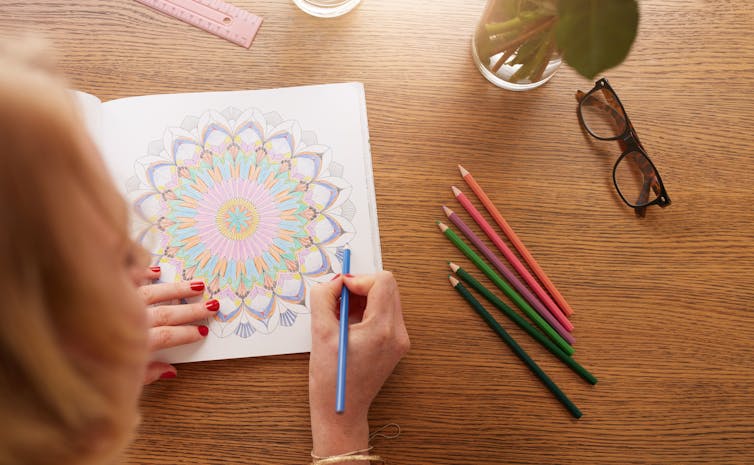When we think of the best ways to reduce stress, we might picture activities such as exercise or meditation. But while these pursuits certainly work for some people, they aren't the only techniques you can use to reduce stress.
Over the past couple of years, adult colouring books have also become a popular hobby for people looking to relax. Although the activity might be simple, our research has shown colouring really can be an effective way of reducing stress and improving wellbeing.
We've shown that colouring is an easy way to lower anxiety and reduce burnout – especially when combined with mindfulness practices.
Mindfulness is the deliberate practice of paying close attention to what's happening in the present moment, without making judgements about any thoughts, emotions or distractions that happen.
Some people use meditation techniques during mindfulness to help them focus – such as concentrating on their breathing to help them stay in the present moment. The act of colouring can also work in a similar way by helping people stay focused on the present. So, we ran a series of studies to see if colouring mindfully could improve people's wellbeing.
In one study, we investigated what effect colouring paired with mindfulness had on the wellbeing of university students. We divided 72 participants into two groups. One group received a colouring page and were told how to practice mindfulness while colouring.
Instructions included guidance on relaxing their body, focusing their attention on the task and sensation of colouring, and what to do if they found their mind was wandering. The other group simply coloured without any mindfulness guidance.
After the session, the group with mindfulness instructions reported feeling less anxious and more focused after colouring. The non-mindfulness group did not experience similar benefits. This suggests that using mindfulness while colouring can help to lower anxiety. However, some people didn't like having instructions while colouring, which reduced the benefits of mindful colouring.
In another experiment, we investigated what effect using videos to teach mindful colouring had on 35 teachers from the UK. Participants were split into two groups. One group was given a daily mindful colouring activity for a total of five days. The other group continued with their working week as usual.
The teachers who practised mindful colouring reported feeling less stressed and more mindful and resilient. Learning how to colour mindfully before the activity may have helped participants to reap the best rewards from it.

But a question that still remained after our research was whether mindful colouring offers similar benefits as traditional meditation practices. This is why we conducted another experiment, which compared colouring to meditation.
We looked at mindful colouring versus a specific type of meditation practice called loving-kindness meditation. Typically just used during meditation, this helps cultivate benevolence by focusing on sending good wishes or thoughts to yourself and others, and is shown to improve wellbeing and reduce stress.
We divided 180 participants into two groups. One group received a colouring page and were told how to practice loving-kindness colouring. The other group was taught how to practice loving-kindness meditation.
The results showed that colouring and meditating with loving-kindness helped people equally well to be more mindful and less anxious. This means that mindful colouring may work just as well as meditation in reducing anxiety.
Being mindful
Overall, our research shows that colouring can be a great way to relax and feel better – especially when combined with mindfulness. This may be because mindfulness reminds people to stay present in the moment and overcome feelings and thoughts that cause them stress.
Research in mindfulness indicates it can also have many other health benefits, including reducing pain and even insomnia. If you want to try mindful colouring yourself, start by finding a quiet and comfortable place where you can focus without distractions.
Choose your materials wisely. Having too many colours may be distracting. Abstract colouring pages can be more useful in allowing you to focus on the activity, rather than choosing logical colours for objects – such as trees or eyes.
While you're colouring, observe your thoughts. If they wander off, or any other thoughts or feelings come up, simply let them go. Refocus on the colours transferring onto the page or your hand movements. It's all about being present, so every time your mind wanders off, let it go and refocus on colouring.
If colouring isn't your thing, research shows that mindfulness can be used alongside a range of other activities and still confer wellbeing and mental health benefits.
For example, drawing can help people to manage their anxiety, as can knitting. Even mindfully doing simple chores such as washing the dishes can be effective. Walking can also help to reduce stress.
Whatever activity you choose, no matter how simple, can still have a positive effect on wellbeing if you focus on being in the moment.![]()
Michael Mantzios, Professor of Applied and Experimental Psychology, Birmingham City University and Kyriaki Giannou, Lecturer in Applied Psychology, Birmingham City University
This article is republished from The Conversation under a Creative Commons license. Read the original article.
